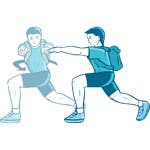Your Longest Dayhike Ever



The Demands
Consider this a low-intensity marathon: Repeating the same motion for hours on end will slowly sap your quads and glutes, making the last few miles feel like a slog through quicksand.
The Strategy
Muscular endurance, as opposed to raw strength, is your goal. In our plan, you’ll build a cardiovascular base that will keep oxygen flowing to your aching legs. You’ll also do exercises specifically targeted at building a lean lower body that can go both hard and long, so your pace doesn’t falter when you hit the last hills.
The Workout
The ingredients are simple: strength-building, aerobic activity, and rest. And the routine is simple: two strength circuits per week, one of which follows an aerobic workout so your muscles get used to working hard after a sweat session. And take 2 days off.
Get Fit: The Overview
During the week, go for two hikes or trail runs, concentrating on a quick pace; work up to a 75-minute session about 2 weeks out. Carry a light pack.
On weekends, mix it up. Spend a day doing whatever cardio activity you enjoy–basketball, mountain biking, whatever. Start with an hour, and work up to 4 hours about 2 weeks before your big dayhike. The other weekend day, hike with your full-weight pack: Your first week out, cover half the distance and elevation gain you will reach during your goal hike; build up to 75 percent 3 weeks before the big day. On the next several pages you’ll find an 8-week, 7-day training plan to really help you get fit.
Week 1 | Week 2 | Week 3 | Week 4 | Week 5 | Week 6 | Week 7 | Week 8
Strength-Training exercises | Extra Credit
Click here to download the 8-week training plan.
*RPE refers to the rate of perceived exertion, a fancy sounding term that merely expresses the difficulty of a workout from one to ten. An RPE of 1 means you’re barely breaking a sweat; a 10 means you’re burning in lactic hell.
Click here to download the 8-week training plan.
Build Strength
Use these exercises to increase your endurance, strength, and balance.
Twice a week, do two sets of 15 to 20 reps of each exercise, unless otherwise noted. Focus on quick movements, without sacrificing form.
1. Rotating Lunge
Builds: Quads, hamstrings, calves, glutes, core
Place your feet hip-distance apart and shoulder a light pack (10 pounds max). With both hands in front of you, lunge forward with your left leg, making sure your left knee and ankle stay in line. As you bend your front knee to 90 degrees, twist your upper body to the left, keeping your back straight and shoulders back. Then, in one motion, twist back to center and return to the starting position. Repeat on the right to complete your first rep.

2. Step-up
Builds: Quads, hamstrings, calves, glutes, climbing strength
Stand in front of a 12-inch platform–a step, stable rock, or low chair. Step up with your right leg, placing your whole foot on the platform, then follow with your left leg. Step down, right leg first, then the left. Do 15 reps on each side.

3. Inchworm
Builds: Core strength
Starting with your feet a few inches apart, bend at the hips and place your hands on the ground a few inches in front of your feet. With tight abs and glutes, slowly move your feet back until you’re nearly horizontal (think of a push-up). Then inch your arms back toward your feet to finish one rep.

4. One-leg hop
Builds: Leg strength, ankle stability, balance
Stand on your right foot, keeping your left knee bent at a 45-degree angle. Push off from your toes and hop 6 inches to right, then 6 inches to left; continue hopping across imaginary line for 30 seconds. Change legs, and repeat.

Extra Credit
Add intervals to your hikes or runs: pick up the pace for 1 to 3 minutes, ease off for a minute, then pick it up again. Repeat 5 to 10 times, depending on your energy level. Intervals build cardiovascular capacity, which helps you go faster for longer.
At the end of a run, find a slight decline and run hard for about a minute. Your cardiovascular system won’t be taxed, but you’ll practice fast foot turnover, which will help you cover more miles with less effort.
On the weekend hikes, occasionally load your pack with a little more weight than you’ll carry during your goal hike. You’ll increase lower body strength, and you’ll feel like you’re flying when the big day comes.